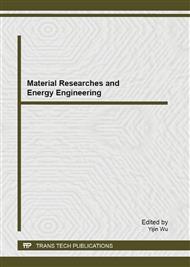[1]
R. McCaffrey, Climate Change and the Cement Industry, Global Cement and Lime Magazine, (2002), pp.15-19.
Google Scholar
[2]
J. Davidovits, Global Warming Impact on the Cement and Aggregates Industries, World Resource Review, 6(2), (1994), pp.263-278.
Google Scholar
[3]
J. Davidovits, Geopolymer chemistry and Applications, 3rd edition, Institute Geopolymer, Saint-Quentin, France, (2011).
Google Scholar
[4]
J. Davidovits, Ancient and modern concretes: what is the real difference, Concrete International, 12, (1987), p.23–25.
Google Scholar
[5]
VM. Malhotra, Role of Supplementary Cementing Materials and Superplasticizers in Reducing Greenhouse Gas Emissions. Proceedings of ICFRC International Conference on Fiber Composites, High Performance Concrete, and Smart Materials, Chennai, India, (2004).
Google Scholar
[6]
D. Hardjito and BV. Rangan, Development and Properties of Low-Calcium Fly ash based Geopolymer Concrete, Research report GC-1, Curtin University of Technology, Perth, Australia, (2005).
Google Scholar
[7]
P, Duxson et al., Geopolymer Technology: the current state of the art. Journal of Materials Science, 42(9), (2007), p.2917–2933.
Google Scholar
[8]
P. Duxson et al., The role of inorganic polymer technology in the development of green concrete. Cement and Concrete Research, 37(12), (2007), p.1590–1597.
DOI: 10.1016/j.cemconres.2007.08.018
Google Scholar
[9]
J. Davidovits, Chemistry of Geopolymeric Systems, Terminology. Proceeding of Geopolymer '99, Saint-Quentin, France, (1999).
Google Scholar
[10]
P. Duxson, Effect of Alkali cations on Aluminum incorporation in Geopolymeric gels. Industrial & Engineering Chemistry Research, 44(4), (2005), pp.832-839.
DOI: 10.1021/ie0494216
Google Scholar
[11]
W. Hongling et al., Synthesis And Mechanical Properties Of Metakaolinite-Based Geopolymer, Colloids Surf. A: Physicochem . Eng. Asp, 268, (2005), pp.1-6.
Google Scholar
[12]
D. Hardjito et al., Fly ash-based geopolymer concrete, Australian Journal of Structural Engineering, Vol. 6, No. 1, Australia, (2005).
Google Scholar
[13]
A.M. Mustafa Al Bakri. et al., The Effect Of Alkaline Activator Ratio On The Compressive Strength Of Fly Ash-Based Geopolymers, Australian Journal of Basic and Applied Sciences, 5(9), (2011), p.1916-(1922).
Google Scholar


